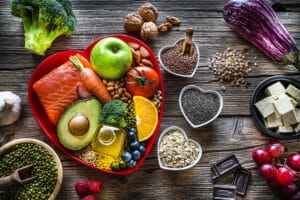Virtually every culture promotes some kind of fermented food/beverage. That is not surprising when you consider the tremendous health benefits from the probiotics that fermentation produces. Kefir is one of the best. Join in and learn to grow your own probiotics, starting with kefir.
Fermented foods are significant sources of amino acids, vitamins and minerals. The bacteria in fermented foods are potent detoxifiers. They produce substances that inhibit harmful bacteria such as salmonella, and they can eradicate H. Pylori, the bacteria responsible for the majority of gastric ulcers.
This is a three part series. By the time you have read the last installment, hope is that you will be convinced fermentation is not only cheaper and better for you than probiotic capsules, but you will have learned to grow your own probiotics. You have to eat anyway, so why not get the most for your money? Making fermented food doesn’t cost any more than the cost of the food once you have your initial supplies, and members of many yahoo groups offer things for no more than the cost of postage.
Kefir is the mother culture of all dairy fermentations
Kefir is a dairy fermentation traditionally begun with the addition of “grains” of kefir culture to milk . If you are vegan, lactose intolerant or allergic to casein, please continue reading as there are alternatives to dairy ferments.
Kefir is considered to be the mother culture of all dairy ferments. Dominic N. Anfiteatro, who is probably the most knowledgeable person in the world today when it comes to kefir says: “I regard kefir grains to be Probiotic-Jewels… and their culture-product kefir a Probiotic-Gem”.
Kefir originated in the Caucasus Mountains. The word kefir is derived from the Turkish word keif, which loosely translates to “feeling good”. This makes perfect sense as those who drink kefir regularly claim it promotes a sense of well-being. The Caucasus peoples enjoyed longevity of over 100 years. There is a legend that kefir grains were a gift from the prophet Mohammed, and the Caucasus feared they would lose their strength if they gave away the kefir grains or the secret of making kefir got out. Others heard of the “magical” properties of kefir and word spread. Even Marco Polo mentioned it. But then kefir was forgotten for centuries until news spread of its successful use in the treatment of tuberculosis, intestinal and stomach diseases. The first commercial kefir was sold in 1908.
The word ‘grains’ is a bit misleading. Kefir culture actually look like little pieces of cauliflower and has absolutely no relationship to cereal grains. Kefir culture is composed of a firm gel-like mass of proteins, fats and polysaccharides. The organisms found in kefir can be divided into 4 genus groups:
- Lactobacilli
- Streptococci-Lactococci
- Acetobacter
- Yeasts
Kefir contains as many as 35 different strains of bacteria and yeast.
Commercial Kefir starters are available and contain 10-15 organisms, while the bottled kefir you buy in the store contains a maximum of 10 strains. It is very simple to make your own, taking about 5 minutes a day. It is also quite simple to prepare cheese from kefir.
Kefir has a creamy consistency with a slightly tangy taste depending on how long it’s been fermented. It can get as thick as yogurt. Many people drink kefir after culturing for 24 hours then straining. However, by doing this they are missing out on many of the benefits of kefir. For example, by ripening kefir another 24 hours, the content of folate is increased 116%.
Other healing properties of kefir
Besides kefir’s obvious probiotic value, it possesses other healing properties. Kefir grains produce a polysaccharide known as kefiran. Research in Japan found that rats with tumors, which were fed kefiran, had reduction in tumor size. Kefiran is also proving to have anti-inflammatory properties.
Research shows regularly eating the grains themselves can lower blood pressure, cure constipation, and control blood glucose. There is evidence that ingesting kefir grains can effectively treat Crohn’s disease and even autism. Kefir and kefir grains can also greatly aid in the elimination of Candidiasis.
There is a common misconception among most people battling Candida that all yeasts are bad and that fermented foods will make you sicker. This simply isn’t true when talking about live lacto-fermented foods. Yeasts are in the air so every time we breathe or swallow, we are putting yeasts into our bodies. There is no way to avoid exposure to yeasts unless you live in a bubble. If all yeasts were bad, we couldn’t survive. Candida albicans is a normal part of microbial flora in the intestines and only causes problems when its growth gets out of control. Sadly, the standard American diet is the perfect vehicle to stimulate massive proliferation of Candida albicans.
Candida is normally a smooth rounded bud and is harmless in this stage. When the colony reaches a “critical mass” in the large intestine and is running out of food, Candida has the ability to morph from the round bud to a thread-like shape. It then migrates in search of food and the threads are able to wreak havoc by poking holes in the small intestine. Instead of vital nutrients being absorbed by the small intestine, approximately 180 toxins produced by Candida are given direct access to the bloodstream. This phenomenon is called leaky gut syndrome. Undigested food particles, toxins and other chemicals all cause inflammatory reactions once outside the protected confines of the intestines, and this inflammation is the cause of myriad diseases and syndromes.
Unfortunately, mainstream medicine refuses to recognize the role of Candida in inflammation.
The yeasts and bacteria present in kefir and other lacto-fermented foods are actually able to displace Candida on the intestinal wall allowing these holes to heal. Once the leaky-gut is resolved and toxins no longer pass into the bloodstream and tissues of the body, healing can begin. Lacto-fermented foods are key players in combating Candida albicans overgrowth, and dairy kefir provides the most comprehensive combination of beneficial organisms.
Dairy alternatives
Milk kefir grains can be used to ferment alternative milks such as seed/nut milks, quinoa milk, coconut and rice milk. The grains will not grow in such mediums and will eventually stop fermenting, and kefiran is not produced. You do however, reap all the other benefits, especially the probiotic benefits of fermenting milk.
Another alternative is water kefir. Water kefir grains are like squishy crystals and are used to ferment sugar, water and fruits. You can create your own carbonated soda-like beverages with water kefir and get many of the same probiotic benefits, however the organisms are not identical to milk kefir grains. You can convert milk grains to culture other mediums, but water grains don’t generally do a good job with dairy.
While kefir will work with all milk, even powdered, it does like a little fat. Raw milk (cow or goat) from grass fed animals is the best choice. If you can’t get raw, try and find milk that has been pasteurized but not homogenized. Ultra pasteurization is the most damaging to the structure of the milk proteins, but that is often the only way you can get organic milk. Above all, avoid milk that comes from conventionally raised cows.
If you are lactose intolerant, the initial 24-hour fermentation will remove about 50% of the lactose, which is the food for the organisms. Ripening the kefir after straining for an additional 24 hours at room temperature or for several days in the refrigerator, will remove almost all the lactose. Many people who are lactose intolerant are able to drink raw milk even without fermenting, as the enzyme lactase is still present.
For some people, the tart taste of kefir may take a little getting used to. Here are a couple of recipes for smoothies. You can use stevia, honey or another natural sweetener of choice.
Mint Chocolate Smoothie
8 to 10 oz kefir
1 heaping tablespoonful cocoa powder
¼ teaspoonful peppermint extract
1 raw egg
1 tablespoonful chia seed
Stevia to taste
Blend and enjoy
Berry Smoothie
8 to 10 oz kefir
¼ cup berries of choice
½ teaspoonful vanilla extract
1 raw egg
1 tablespoonful chia seed
Stevia to taste
Blend and enjoy



